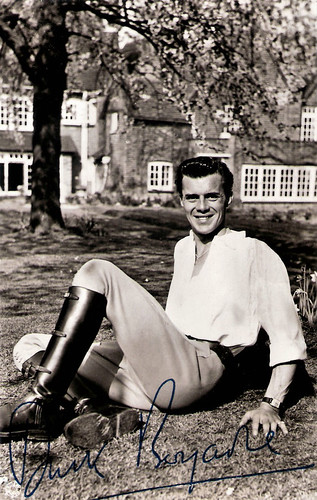
British autograph card. Photo: J. Arthur Rank Organisation.

Mexican card, no. 356. Photo: Rank.
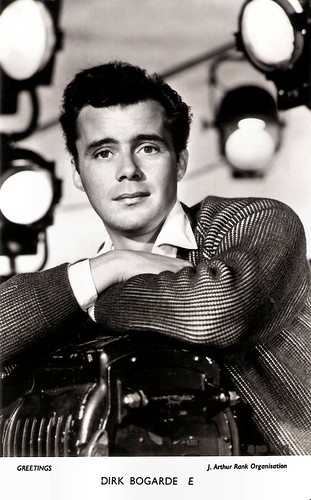
British Greetings card, no. E. Photo: J. Arthur Rank Organisation.
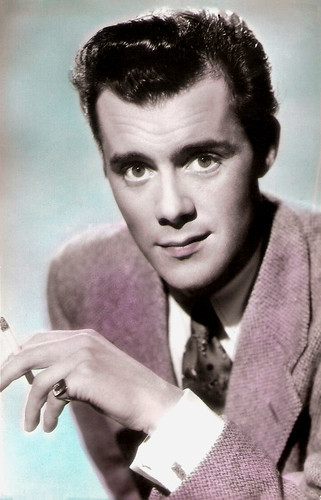
Yugoslavian postcard by Jugoturist, Beograd / Studio Sombor, no. 191.
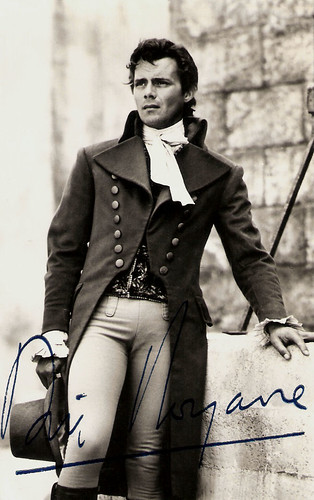
British postcard. Photo: Rank. Publicity still for A Tale of Two Cities (Ralph Thomas, 1958).
A dark and violent sexuality
Dirk Bogarde was born Derek Jules Gaspard Ulric Niven van den Bogaerde in London in 1921. He was of mixed Flemish, Dutch and Scottish ancestry. His father, Ulric van den Bogaerde was the art editor of the London newspaper The Times and his mother Margaret Niven was a former actress. He attended the former Allan Glen's School in Glasgow and London's University College School, before majoring in commercial art at Chelsea Polytechnic. Derek dropped out of his commercial art course and became a drama student, though his acting talent at that time was unpromising. In the late 1930s, he went to work as a commercial artist and a scene designer. His London West End acting debut was in 1939 as Derek Bogaerde in J. B. Priestley's play 'Cornelius'. That same year he appeared as an extra in the George Formby film Come On George! (Anthony Kimmins, 1939).
In 1940, nineteen-year-old Derek joined the Queen’s Royal Regiment and served as an officer with the Air Photographic Intelligence Unit, where he eventually attained the rank of major and during his five years of active service was honoured on seven occasions. After the war, his agent renamed him Dirk Bogarde, and in 1947 he appeared in Power Without Glory at the New Lindsay Theatre, a performance that was praised by Noel Coward, who urged him to continue his acting career. His good looks helped him begin a career as a film actor. After several films for Gainsborough, none of them making much impact, his first lead came when Wessex Films gave him a part in the proposed Stewart Granger film Esther Waters (Ian Dalrymple, Peter Proud, 1948). When Granger dropped out, Bogarde took over the lead.
Rank subsequently signed him to a long-term contract and he appeared in a variety of parts during the 14 years he was under contract to this studio. He came to prominence playing the charismatic young hoodlum who shoots and kills a police constable in Ealing's The Blue Lamp (Basil Dearden, 1949). Bogarde brought dark and violent sexuality to the role that came near to unbalancing the film's sober intentions. It was the first of the intense neurotics and attractive villains that Bogarde would often play, such as the murderer, who befriends a young boy, he played in Hunted (Charles Crichton, 1952).
His role as a medical student in Doctor in the House (Ralph Thomas, 1954) made Bogarde one of the most popular British stars of the 1950s. A staggering 17 million people saw the film in its first year. In the next years he reprised his role in Doctor at Sea (Ralph Thomas, 1955) co-starring Brigitte Bardot, and Doctor at Large (Ralph Thomas, 1957) co-starring the later Bond girl Shirley Eaton.
He played a neurotic criminal opposite Alexis Smith in The Sleeping Tiger (1954), Bogarde's first film for American expatriate director Joseph Losey. In Cast a Dark Shadow (Lewis Gilbert, 1955), he was a man who marries women for money and then murders them. Other interesting films were The Spanish Gardener (Philip Leacock, 1956); A Tale of Two Cities (Ralph Thomas, 1958), a faithful retelling of Charles Dickens's classic; The Doctor's Dilemma (Anthony Asquith, 1959), based on a play by George Bernard Shaw; and Libel (Anthony Asquith, 1959), in which he played two separate roles opposite Olivia de Havilland.
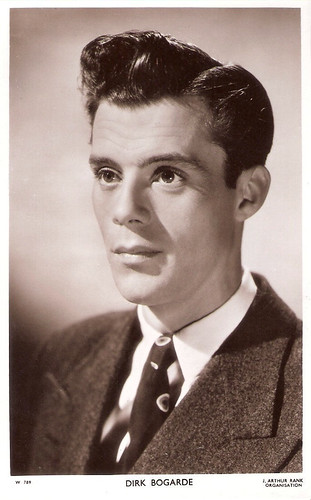
British postcard by Picturegoer Series, London, no. W. 789. Photo: J. Arthur Rank Organisation.

British postcard in the Picturegoer Series, London, no. D 547. Photo: Associated British.

British postcard in the Picturegoer Series, London, no. D 290. Photo: British Lion.
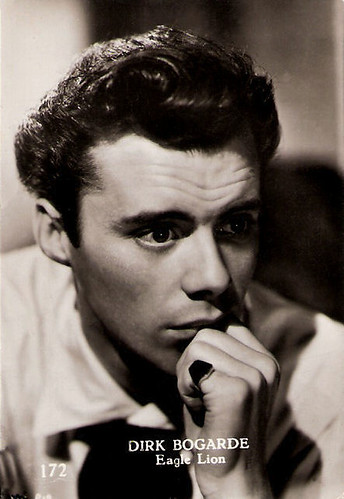
Vintage minicard, no. 172. Photo: Eagle Lion.

British card. Photo: Eagle Lion.
Victim
After leaving the Rank Organisation, Dirk Bogarde went to Hollywood. There he played Hungarian composer and virtuoso pianist Franz Liszt in Song Without End (Charles Vidor, George Cukor, 1960), and an unfrocked priest who falls in love with cabaret entertainer Ava Gardner during the Spanish Civil War in The Angel Wore Red (Nunnally Johnson, 1960). Both were big-budgeted films but hampered by poor scripts, and neither fared well. Bogarde decided to avoid Hollywood productions in the future.
He abandoned his heart-throb image for more challenging parts. First, he starred in the landmark film Victim (Basil Dearden, 1961). He played Melville Farr, a prominent and secretly homosexual lawyer who fights the blackmailers of a young man with whom he had a relationship. The young man commits suicide after being arrested for embezzlement, rather than to ruin the attorney's reputation. In the process of exposing the ring of extortionists, Bogarde's character puts at risk his successful legal career and marriage in order to see that justice is served.
Victim was the first mainstream British film to treat the subject of homosexuality seriously and the film helped lead to a change in English law decriminalising homosexuality. Acting in Victim was a very brave move of Bogarde in the years before the decriminalisation of male homosexuality with the 1967 Sexual Offences Act.
Privately he had a long-term relationship with his manager, Anthony Forwood since 1939. Forwood was the former husband of the actress Glynis Johns and the father of her only child, actor Gareth Forwood. They lived together, first in Amersham, England, then in France. According to Wikipedia, Bogarde's refusal to enter into a marriage of convenience in order to cover up his homosexuality was probably a major reason for his failure to become a star in Hollywood, together with the critical and commercial failure of Song Without End.
In Europe he played classic roles in more complex, art house films such as the decadent valet Hugo Barrett in The Servant (Joseph Losey, 1963) written by Harold Pinter; television reporter Robert Gold in Darling (John Schlesinger, 1965) starring Julie Christie; Stephen, a bored Oxford University professor in Accident (Joseph Losey, 1967) also written by Pinter; German industrialist Frederick Bruckman in La caduta degli dei/The Damned (Luchino Visconti, 1969); the Nazi ex-concentration camp guard obsessed with one of his previous inmates (Charlotte Rampling) in the chilling and highly controversial Il portiere di notte/The Night Porter (Liliana Cavani, 1974), and, most notably, in Morte a Venezia/Death in Venice (Luchino Visconti, 1971) as Gustav von Aschenbach, a dying composer obsessed with a beautiful boy in a city ravaged by cholera.
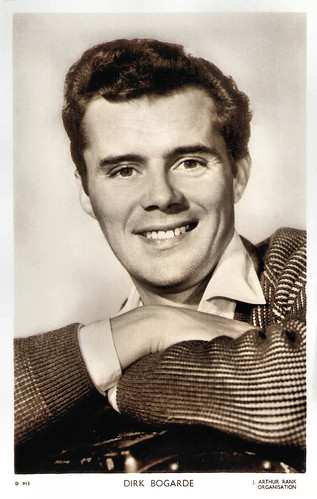
British postcard in the Picturegoer Series, London, no. D 913. Photo: J. Arthur Rank Organisation.
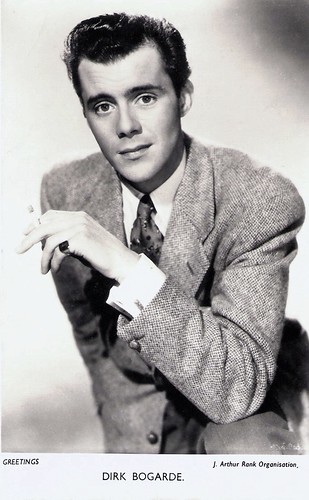
British postcard. Photo: J. Arthur Rank Organisation.
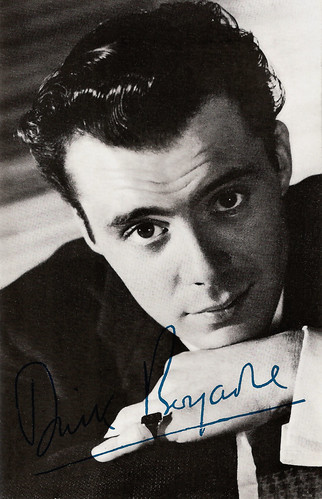
British postcard in the Film Star Autograph Portrait Series by Celebrity Publishers, London, no. 51. Photo: Cornel Lucas / Rank.
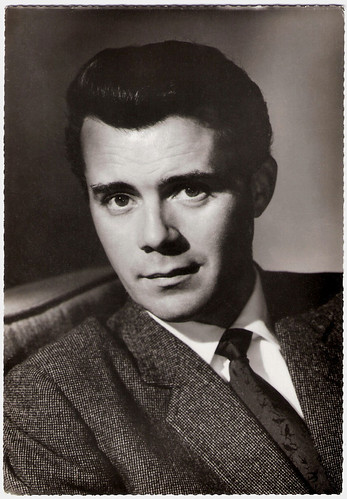
Yugoslavian postcard by ZK, no. 4236. Photo: Rank.
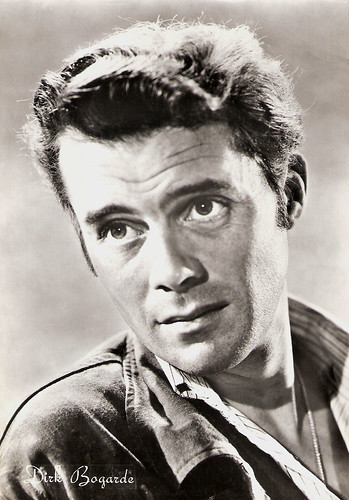
Italian postcard by Rotalfoto, Milano, no. 863.
Second Career
During the 1960s and 1970s, Dirk Bogarde played opposite renowned stars, yet several of the films were of uneven quality. In the campy The Singer Not the Song (Roy Ward Baker, 1961), he was a Mexican bandit co-starring with John Mills as a priest. In H.M.S. Defiant (Lewis Gilbert, 1962), he played sadistic Lieutenant Scott-Padget opposite Sir Alec Guinness. In I Could Go On Singing (Ronald Neame, 1963), he co-starred with Judy Garland in her final screen role.
In King & Country (Joseph Losey, 1964) he played an army lawyer reluctantly defending deserter Tom Courtenay. Losey's Modesty Blaise (Joseph Losey, 1966) was a campy spy send-up in which he co-starred as archvillain Gabriel opposite Monica Vitti and Terence Stamp. Our Mother's House (Jack Clayton, 1967) was an off-beat film in which he played an estranged father of seven children. In The Fixer (John Frankenheimer, 1968), based on Bernard Malamud's novel, he co-starred with Alan Bates; in Oh! What a Lovely War (Richard Attenborough, 1969), his co-stars were Sir John Gielgud and Sir Laurence Olivier, and in Le Serpent/The Serpent (Henri Verneuil, 1973) he appeared with Henry Fonda and Yul Brynner.
In 1977, Bogarde embarked on his second career as an author. Starting with the first volume, 'A Postillion Struck by Lightning' (1977), he wrote a series of autobiographical volumes, novels, and book reviews. While in his autobiographical works, Bogarde carefully avoids direct discussion of homosexuality, he does discuss his relationship with his partner, particularly his care of him during the latter's long terminal illness. According to Wikipedia, the writer Bogarde displayed a witty, elegant, highly literate, and thoughtful style.
Among his later films were the art-house hit Providence (Alain Resnais, 1977) co-starring Sir John Gielgud; the all-star blockbuster A Bridge Too Far (Richard Attenborough, 1977), and the Vladimir Nabokov adaptation Despair (Rainer Werner Fassbinder, 1978). His final film role was in Daddy Nostalgie/These Foolish Things (Bertrand Tavernier, 1991) co-starring Jane Birkin as his daughter. Bogarde's controversial film choices later in his career led him to have something of a cult following. Formerly a heavy smoker, Bogarde suffered a minor stroke in November 1987 while Anthony Forwood was dying of liver cancer and Parkinson's disease. Never afraid of voicing his opinion, after witnessing Forwood's protracted death he became active in promoting voluntary euthanasia for terminally ill patients in Britain and toured the UK giving lectures and answering questions from live audiences on the subject.
Dirk Bogarde died in London from a heart attack in 1999, aged 78. He was nominated six times as Best Actor by the British Academy of Film and Television Arts (BAFTA), winning twice for The Servant in 1963 and Darling in 1965. He also received the London Film Critics Circle Lifetime Award in 1991. He was knighted in 1992 for services to acting and was the recipient of honorary doctorates from several universities including St Andrews and Sussex. In the Encyclopedia of British Cinema, Brian McFarlane writes about Bogarde: "he was the British film actor and star par excellence, sometimes making bricks out of straw but also making impressive houses out of bricks."
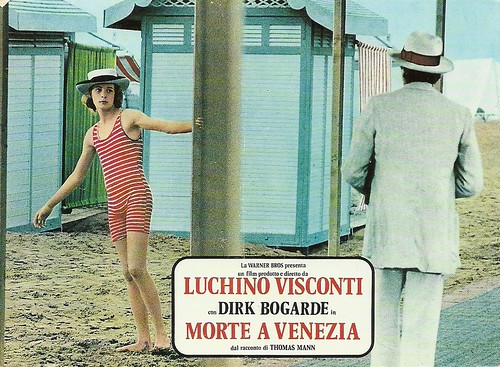
Dutch postcard, using the original poster, for a Dutch rerelease of the film. Björn Andresen and Dirk Bogarde in Morte a Venezia/Death in Venice (Luchino Visconti, 1972).
Trailer for Victim (1961). Source: HD Retro Trailers (YouTube).
Trailer for The Servant (1963). Source: Fury (YouTube).
Trailer for Darling (1965). Source: Maynard G. Krebs (YouTube).
Trailer for Morte a Venezia/Death in Venice (1971). Source: amazondigitalfilmes (YouTube).
Sources: Jon C. Hopwood (IMDb), Brian McFarlane (Encyclopedia of British Cinema), Patricia Juliana Smith (glbtq), David Absalom (British Pictures), Clive Saunders (BritMovie - now defunct), Wikipedia, and IMDb.
This post was last updated on 12 June 2023.
5 comments:
You have probably the most elaborate and researched blogposts that I know. Always an interesting read! :)
what dorin said!!! dirk bogarde, a name i recognize and a face from his later work. happy pff!
A great actor Apparently Visconti only gave him one direction when filming Death in Venice which was to look up as the boat goes under the bridge. A superb scene as the Mahler swells in the background.
I am learning so much today as I visit all the PFF entries. Thank-you.
Now we're getting into dangerous territory - I remember him only too well! That makes me part of history now.
Post a Comment